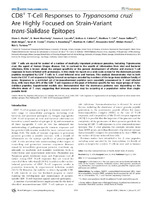Use este identificador para citar ou linkar para este item:
http://sgc.anlis.gob.ar/handle/123456789/395| Título: | CD8+ T-Cell responses to Trypanosoma cruzi are highly focused on strain-variant trans-sialidase epitopes | Autor(es): | Martin, Diana L. Weatherly, Brent D. Laucella, Susana A. Cabinian, Melissa A. Crim, Matthew T. Sullivan, Susan Heiges, Mark Craven, Sarah H. Rosenberg, Charles S. Collins, Matthew H. Sette, Alessandro Postan, Miriam Tarleton, Rick |
Palavras-chave: | Trypanosoma cruzi;Epítopos;Linfocitos T;Enfermedad de Chagas | Data do documento: | 2006 | Jornal: | Plos Pathogens | Resumo: | CD8+ T cells are crucial for control of a number of medically important protozoan parasites, including Trypanosoma cruzi, the agent of human Chagas disease. Yet, in contrast to the wealth of information from viral and bacterial infections, little is known about the antigen specificity or the general development of effector and memory T-cell responses in hosts infected with protozoans. In this study we report on a wide-scale screen for the dominant parasite peptides recognized by CD8+ T cells in T. cruzi–infected mice and humans. This analysis demonstrates that in both hosts the CD8+ T-cell response is highly focused on epitopes encoded by members of the large trans-sialidase family of genes. Responses to a restricted set of immunodominant peptides were especially pronounced in T. cruzi–infected mice, with more than 30% of the CD8+ T-cell response at the peak of infection specific for two major groups of trans-sialidase peptides. Experimental models also demonstrated that the dominance patterns vary depending on the infective strain of T. cruzi, suggesting that immune evasion may be occurring at a population rather than single-parasite level. |
Descrição: | Fil: Martin, Diana L. University of Georgia. Center for Tropical and Emerging Global Diseases; Estados Unidos. Fil: Weatherly, D. Brent. University of Georgia. Center for Tropical and Emerging Global Diseases; Estados Unidos. Fil: Laucella, Susana A. ANLIS Dr.C.G.Malbrán. Instituto Nacional de Parasitología; Argentina. Fil: Cabinian, Melissa A. University of Georgia. Department of Microbiology; Estados Unidos. Fil: Crim, Matthew T. University of Georgia. Department of Cellular Biology; Estados Unidos. Fil: Sullivan, Susan. University of Georgia. Department of Cellular Biology; Estados Unidos. Fil: Heiges, Mark. University of Georgia. Center for Tropical and Emerging Global Diseases; Estados Unidos. Fil: Craven, Sarah H. University of Georgia. Department of Microbiology; Estados Unidos. Fil: Rosenberg, Charles S. University of Georgia. Center for Tropical and Emerging Global Diseases; Estados Unidos. Fil: Collins, Matthew H. University of Georgia. Department of Cellular Biology; Estados Unidos. Fil: Sette, Alessandro. La Jolla Institute for Allergy and Immunology; Estados Unidos. Fil: Postan, Miriam. ANLIS Dr.C.G.Malbrán. Instituto Nacional de Parasitología; Argentina. Fil: Tarleton, Rick L. University of Georgia. Center for Tropical and Emerging Global Diseases; Estados Unidos. |
URI: | http://www.plospathogens.org/article/info%3Adoi%2F10.1371%2Fjournal.ppat.0020077 http://sgc.anlis.gob.ar/handle/123456789/395 |
ISSN: | 1553-7374 | Direitos: | Open Access Creative Commons Attribution 4.0 International License |
| Aparece nas Coleções: | snrd Publicaciones INP |
Arquivos neste item:
| Arquivo | Descrição | Tamanho | Formato | |
|---|---|---|---|---|
| PLoSpathogens,2006,2(8),e77..pdf | 343.83 kB | Adobe PDF |  Ver/Aberto |
Visualização de página
151
Checado em 08/12/2025
Download(s)
81
Checado em 08/12/2025
Google ScholarTM
Checar
Este item está licenciada sob uma Licença Creative Commons


